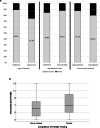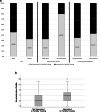Contraceptive methods and fertility testing in young adult survivors of childhood cancer
- PMID: 37584730
- PMCID: PMC10504164
- DOI: 10.1007/s10815-023-02908-7
Contraceptive methods and fertility testing in young adult survivors of childhood cancer
Abstract
Purpose: Reproductive health is important, but often neglected in cancer survivorship care. This study explored contraceptive use and factors associated with fertility testing among young adult survivors of childhood cancer in Germany.
Methods: Young adult survivors of childhood cancer were identified through the German Childhood Cancer Registry and completed a mailed survey. Survivors were queried regarding contraceptive use, reproductive goals, uncertainty about fertility, and completion or interest in fertility testing. Multivariable stepwise logistic regression models were used to calculate Odds Ratios (OR) and 95% confidence intervals (CI) as a means of identifying factors associated with completion of and interest in fertility testing.
Results: Survivors (N = 472; 57.8% female; aged 23.3 ± 1.5 years, and 14.9 ± 5.0 years from diagnosis), reported high rates of contraceptive use, including 61.2% using a single method, 30.6% dual methods, and 8.1% no/less effective methods. Few survivors had completed fertility testing (13.0%), although 58.8% were interested. Having been diagnosed during adolescence (OR = 2.66, 95%CI: 1.39-5.09), greater uncertainty about fertility (OR = 1.16, 95%CI: 1.03-1.31), and use of dual contraceptive methods (OR = 1.94, 95%CI: 1.02-3.69) were associated with having completed fertility testing. Factors associated with interest in fertility testing included goals of wanting to have children (OR = 7.76, 95%CI: 3.01-20.04) and greater uncertainty about fertility (OR = 1.19 95%CI: 1.06-1.33).
Conclusion: In this sample of young adults who survived childhood cancer, most reported contraceptive use. Few survivors had completed fertility testing, although more than half were interested. Interventions are needed to address potential barriers to fertility testing and help survivors manage fertility-related uncertainty.
Keywords: Childhood cancer; Contraception; Fertility testing; Oncofertility; Survivorship; Young adult.
© 2023. The Author(s).
Conflict of interest statement
All authors report no competing interests.
Figures


References
-
- German Childhood Cancer Registry: https://www.kinderkrebsregister.de/dkkrgb/latest-publications/annual-rep.... Accessed July 2023.
-
- Howlader N NA, Krapcho M, Miller D, Brest A, Yu M, Ruhl J, Tatalovich Z, Mariotto A, Lewis DR, Chen HS, Feuer EJ, Cronin KA,: SEER cancer statistics review, 1975-2008, National Cancer Institute, Bethesda, MD. https://seer.cancer.gov/csr/1975_2008/. based on November 2010 SEER data submission, posted to the SEER web site (2011). Accessed Jan 2023.
MeSH terms
Substances
Grants and funding
LinkOut - more resources
Full Text Sources
Medical

